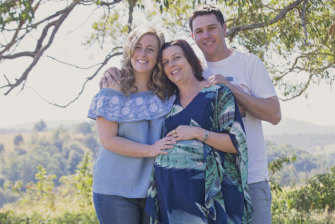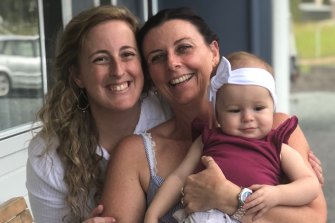Friends have replaced sisters as the most likely person to be a surrogate mother for intended parents who can’t carry a baby.
A long-term study presented at a national fertility conference in Hobart last week suggests nearly half of surrogacy cases involve a surrogate and intended parents who are friends or acquaintances.
Health psychologist and family therapist Miranda Montrone, who co-authored the research, said this had increased over time.
“Early on, it was mostly family. In the late 90s, when it was not well known that this was an option, it tended to be mostly sisters or sisters-in-law,” Ms Montrone said. “Since it's been known and there's been legislation, it's increasingly extended family, friends of people, friends of friends, or friends of extended family.”
Surrogate Leonie McKinnon (centre) pregnant in 2017, with intended parents Rebecca MacDonald and Brodie Ashby.Credit:Susan Lowick
NSW passed the Surrogacy Act in 2010, setting out the rules for surrogacy and explicitly allowing it for the first time. In Australia surrogacy must be an altruistic arrangement, where expenses can be reimbursed but surrogates are not otherwise paid.
The research, based on 160 surrogacy cases nationally seen by Ms Montrone in private practice over 15 years, looks at the characteristics of surrogates, their partners and the intended parents. It includes both heterosexual and same-sex couples and some single women.
Almost half of surrogates are family members of the intended parents, slightly ahead of friends. Sisters of either the intended mother or intended father made up 28 per cent of surrogates, while a further 20 per cent were other close family members such as sisters-in-law and mothers.
Only 5 per cent are strangers, who usually meet through an internet forum or chat group.
The research also reveals Australian surrogates have slightly lower levels of education and socio-economic advantage than the intended parents but there is not the strong class divide seen in other countries, including Britain, which also has an altruistic regime.
Ms Montrone said the research suggests that couples don’t need to go overseas to find a surrogate – a crime in NSW.
“I believe they can find surrogates here if they just don't rush,” she said. “It’s actually quite problematic in [some] compensated regimes because the treatment can revolve around the needs of the intended parents rather than the wellbeing of the woman and that concerns me.”
Leonie McKinnon, 45, from Nabiac on the mid-north coast of NSW was a surrogate for her friends Rebecca MacDonald and Brodie Ashby, both 30.
Ms McKinnon has known the couple since they were 17 when Mr Ashby was her husband’s building apprentice. Ms MacDonald found out at 18 that she had MRKH syndrome, meaning she was born without a uterus.
Rebecca MacDonald with her friend Leonie McKinnon, who was the surrogate for daughter Briar.
“The doctor said, 'you have perfectly fine ovaries, but you can't carry a baby – good eggs, but no uterus',” Ms MacDonald said. “I'm a massive crier so I didn't really talk about it much but Brodie told other people and [Leonie] would often say to me intermittently 'I'll have a baby for you'.”
Ms MacDonald said other friends also offered to be surrogates when they finished having their own babies but by their late 20s very few had even started. She didn’t want to ask her sister who had gone through a difficult labour in case she felt obliged.
Ms Montrone said she knew from counselling that sisters can often feel familial obligation or “implicit coercion” but friends don’t feel that pressure.
The couples eventually ahead with IVF to create an embryo from Ms MacDonald’s egg and Mr Ashby’s sperm and implant it in Ms McKinnon. The baby girl born as a result, Briar, is nearly two.
Ms McKinnon found being pregnant at 43 physically harder than 20 years earlier with her own children but she knew she could cope emotionally with being a surrogate.
“Every woman knows if she could do it or not … and I just always knew I could,” she said.
Source: Read Full Article








